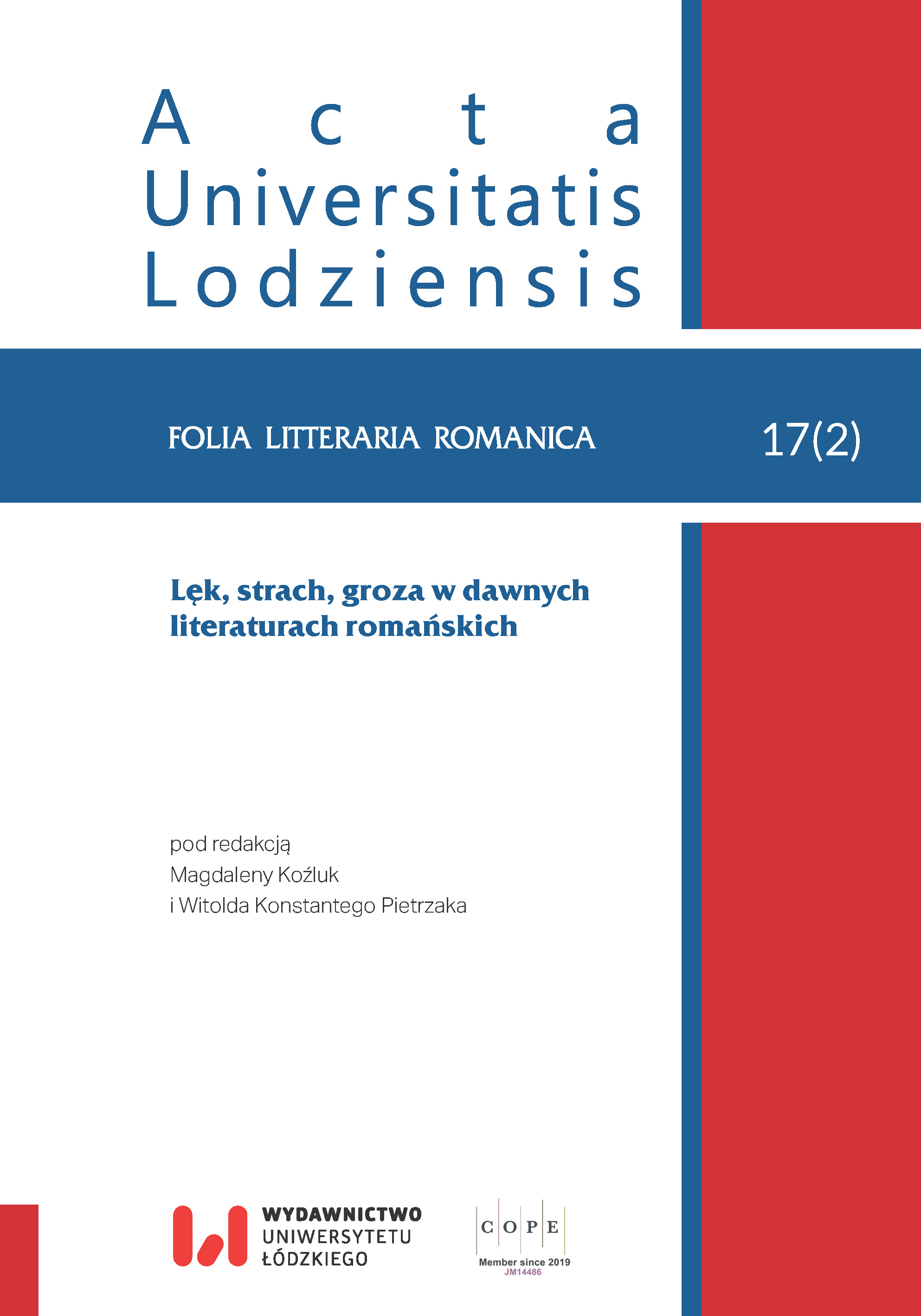Fear of Devil in 13th Century’s Collection of Vie des peres
DOI:
https://doi.org/10.18778/1505-9065.17.2.06Keywords:
devil, fear, ugliness, monstrosity, medieval literature, pious tales, Vie des peresAbstract
The article analyses the vision of the devil in the selected tales of the Vie des peres, a collection of pious tales from the thirteenth century, freely inspired by patristic literature and medieval exempla. The period in which the collection was written, the thirteenth century, bridges the gap between the early and late Middle Ages: it is a time when the perception of the devil is changing, and he is becoming increasingly feared. The analysis focuses mainly on four stories in which the devil is at the centre of the story, and in which his very image is a source of fear and a key element of the story: ‘Devil’s Mouth’, ‘Devils Vision’ and two versions of ‘Devil’s Image’. The vision of the devil in these stories coincides with the teratological vision that is dominant in the iconography, to which the stories directly allude. The message of these stories is generally positive: the protagonists almost always manage to overcome their fears and free themselves from the power of the devil. In this way, the authors avoid the trap of Manichaeism: the devil, despite his cunning and sophistication, is in the end only a caricature of an angel, unable to oppose God effectively. The fear of the devil appears several times on the pages of Vie des peres, but it is the message of hope that dominates.
Downloads
References
Apoftegmaty Ojców Pustyni, t. 2: „Kolekcja systematyczna”, tł. ks. Marek Kozera, Tyniec Wydawnictwo Benedyktynów, Kraków 1995
Google Scholar
Burchard z Wormacji, « Corrector sive medicus », in Cyrille Vogel, Le pécheur et la pénitence au moyen âge, Paris, Cerf, 1969
Google Scholar
Pismo Święte Starego i Nowego Testamentu w przekładzie Jakóba Wujka, Wydawnictwo Księży Jezuitów, Kraków 1935
Google Scholar
Vie des peres, éd. Félix Lecoy, Paris, Picard, t. 1, 1987
Google Scholar
Vie des peres, éd. Félix Lecoy, Paris, Picard, t. 2, 1993
Google Scholar
Vie des peres, éd. Félix Lecoy, Paris, Picard, t. 3, 1999
Google Scholar
Villon, François, Wielki Testament, tł. Tadeusz Żeleński (Boy), PIW, Warszawa 1954
Google Scholar
Baschet, Jérôme, L’Iconographie médiévale, Paris, Folio, 2013 (édition e-book EPUB) Boureau, Alain, « Satan hérétique : l’institution judiciaire de la démonologie sous Jean XXII », in Le Diable en procès. Démonologie et sorcellerie à la fin du Moyen Âge, Médiévales, 2003, no 44, s. 17-46, https://doi.org/10.4000/medievales.711
Google Scholar
DOI: https://doi.org/10.4000/medievales.711
Bretel, Paul, Les Ermites et les moines dans la littérature française du moyen âge (1150-1250), Paris, Champion, 1995
Google Scholar
Delumeau, Jean, Grzech i strach. Poczucie winy w kulturze Zachodu XIII-XVIII w., tł. Adam Szymanowski, Pax-Volumen, Warszawa 1994
Google Scholar
Delumeau, Jean, Strach w kulturze Zachodu. XIV-XVIII w., tł. Adam Szymanowski, Pax, Warszawa 1986
Google Scholar
Frappier, Jean, « Châtiments infernaux et peur du Diable », Cahiers de l’Association internationale des études françaises, 1953, no 3-5, s. 87-96, https://doi.org/10.3406/caief.1953.2020
Google Scholar
DOI: https://doi.org/10.3406/caief.1953.2020
Gonzalez, Julie, Étude iconographique de la Gueule d’Enfer au Moyen Âge. Origines et symboliques, praca doktorska (niepublikowana), dokument dostępny online: http://theses.fr/189265574
Google Scholar
Laurent, Françoise, Plaire et Édifier. Les récits hagiographiques composés en Angleterre aux XIIe et XIIIe siècles, Paris, Honoré Champion, 1998
Google Scholar
Le Goff, Jacques, Kultura średniowiecznej Europy, tł. Hanna Szumańska-Grossowa, Volumen, Warszawa 1995
Google Scholar
Maizuls, Mikhail, « Les portraits dangereux : agentivité des images du diable au Moyen Âge. Dans l’Occident médiéval et dans la Russie des XVIIe-XVIIIe siècles », in Images de la sainteté, images du péché dans le monde orthodoxe, XVIIe-XVIIIe siècles, Revue des Études Slaves, 2019, XC-3, https://doi.org/10.4000/res.2879
Google Scholar
DOI: https://doi.org/10.4000/res.2879
Ostorero, Martine, Anheim, Étienne, « Le diable en procès », in Le Diable en procès. Démonologie et sorcellerie à la fin du Moyen Âge, Médiévales, 2003, no 44, s. 5-16, URL : https://journals.openedition.org/medievales/988 https://doi.org/10.4000/medievales.988
Google Scholar
DOI: https://doi.org/10.4000/medievales.988
Payen, Jean-Charles, « Pour en finir avec le diable médiéval ou pourquoi poètes et théologiens du moyen-âge ont-ils scrupule à croire au démon ? », in Le Diable au Moyen Âge : Doctrine, problèmes moraux, représentations [en ligne], Aix-en-Provence, Presses Universitaires de Provence, 1979 ; URL : http://books.openedition.org/pup/2675
Google Scholar
Schmitt, Jean-Claude, Le Corps des images. Essais sur la culture visuelle au Moyen Âge, Paris, Gallimard, 2002
Google Scholar
DOI: https://doi.org/10.14375/NP.9782070761593
Tubach, Frederic C., Index exemplorum. A Handbook of Medieval Religious Tales, Helsinki, Suomalainen Tiedeakatemia, 1969
Google Scholar
Tudor, Adrian P., Tales of Vice and Virtue. The First Old French Vie des Pères, Amsterdam/New York, Rodopi, 2005, https://doi.org/10.1163/9789004488229
Google Scholar
DOI: https://doi.org/10.1163/9789004488229
Vogel, Cyrille, Le Pécheur et la pénitence au moyen âge, Paris, Cerf, 1969
Google Scholar
Downloads
Published
Versions
- 2023-08-10 (2)
- 2022-12-30 (1)
How to Cite
Issue
Section
License

This work is licensed under a Creative Commons Attribution-NonCommercial-NoDerivatives 4.0 International License.













